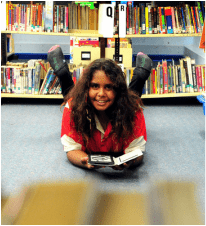What we do
We work to improve the reading ability of Aboriginal and Torres Strait Islander students. Through our E-reading program we target kids who are behind their peers and want to improve their reading skills. We loan them a tablet and give them access to our cloud library. We monitor their progress over time and if they significantly improve their reading ability they get to keep the tablet.
We also provide longer-term support to some students through our Reading for Life (RFL) program.
Why?
Reading is an essential life skill. Those who cannot read fall behind. They are less likely to complete Year 12, or to get to TAFE or university. Poor readers struggle to find work. Even unskilled and low paid jobs require the ability to read. There are thousands of Indigenous kids whose reading ability is a long way behind their non-Indigenous peers. In 2018, 95% of all non-Indigenous kids met the national minimum standard (NMS) for reading. By contrast, only 28% of Indigenous kids from very remote communities reached this basic level of achievement. You can learn more about about the reading achievement of Indigenous kids by visiting the National Assessment Program site.

Source: National Assessment Program - Literacy and Numeracy National Report for 2022, ACARA
How does it work?
E-reading program
We work with teachers to identify kids who have clear potential to succeed in our e-reading program. We loan them tablets and give them access to e-books that are interesting to them. We provide clear goals and positive incentives to encourage them to read more. We measure the reading behaviour and reading achievement of students before they enter the program and again after 12 weeks. If the evidence shows that the student has made good progress then the tablet is given to them as a reward.
1. We find kids who are performing poorly but are motivated to improve. We test them and offer them a place in our program with the incentive of owning a tablet for improved reading ability.
2. We loan students a tablet and give them access to our cloud library to browse through and borrow e-books that interest them.
3. After 12 weeks we test students again. We also collect feedback from teachers, parents and the students themselves.
4. We reward effort and achievement. If the student's test results show significant, measurable improvement and feedback is positive we give the student the tablet to keep.
5. If the students test results are unchanged or lower from the baseline test and feedback is negative then the tablet is returned to us. We then offer the tablet to another student.
6. A select number of very successful students will be offered a place in our Reading for Life (RFL) program. This will provide them with with ongoing support and access to our reading resources through their school life.
Reading for Life
Experience tells us that we need to take the long view and invest in children so they can thrive now and in the future.
In 2018 we introduced our new Reading for Life (RFL) program. We're continuing with our flagship E-reading program, but over time we are going to dedicate more resources and effort to support to those students who have thrived and made an outstanding improvement through our E-Reading Program.

Why are we doing this?
One thing we know is that reading improvements in one year are no guarantee of longer-term success. For example, the national reading results for Year 9 Indigenous students have shown no improvements over the last 10 years. This is in spite of record investments in education. What this means is that we need to continue to innovate and try new approaches.
How does it work?
Each year some of the students we support through our E-reading program perform exceptionally well. Through hard work and support from parents, teachers, and IRP they are able to improve their reading ability significantly. They spend more time reading and they read more fluently and with greater comprehension.
We also receive feedback about other positive changes in the lives of these kids such as increased confidence, improved classroom behaviour, and a better attitude to learning. We believe that these things matter and we want to make sure that these kids can continue to thrive at school by having ongoing access to excellent reading material that engages and inspires them.
The aim of RFL is to embed reading as a lifelong habit so that students can progress through school and transition to further learning and work. The program provides reading resources for participating students for their entire school life. Reading resources include devices (tablets), ongoing library membership, and the ability to request specific e-book purchases for the IRP library. In addition, an IRP engagement officer will be assigned to each student to provide ongoing monitoring and support for students.
Where are we up to?
The Reading for Life program in its second year supported 46 students from across Australia. These students checked out 562 e-books in 2019. In 2020 participation will grow to 80 students. We are very pleased to be supporting a growing number of kids throughout the year in this long-term program.
Please make sure you subscribe to our newsletter so you can follow the progress of some of our RLF students.
